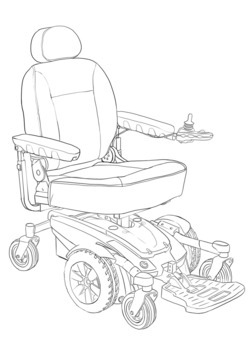Manual chairs are lighter (no motor, no battery) and don’t run out of power – because they have no power, how far and long you can go depends on how much energy you or the person pushing you has. They cost less and are easier to maintain (fewer parts to go wrong). They are easier to load into a car or van. A wheelchair battery (for a power chair) typically weighs 40 pounds. Many people who have power chairs also have at least one manual chair as a backup. Quadriplegics and people without enough arm strength and/or coordination need power chairs.
Power chairs save your energy and make it much easier to go uphill. They also free up one arm and hand for carrying something. Power (Electric) Wheelchairs are also be called “motorized wheelchairs” and sometimes abbreviated EPW (electric powered wheelchairs). Powered by an electric motor, these chairs are navigated by controls systems. Individuals too weak to maneuver a manually powered or standard wheelchair benefit from power chairs, as do individuals with heart and/or breathing conditions. Power electric wheelchairs are intended for use in everyday life and there are power wheelchairs made specifically for indoor and outdoor use.
Motor horsepower ratings for electric wheelchairs run from 0.87 hp to 2.5 hp. Physical dimension also vary – travel-sized motorized chairs tend to be the small and range in length from 28.7” to 37.8,” width can range from 21" to 21.7” and height can range from 19” to 30.5”. Folding power wheelchairs, which tend to be on the larger side, can range in length from 43” to 47,” width can range from 23.5" to 26” and height can range from 38” to 40”. Electric power wheelchair materials are similar to a standard wheelchair’s materials with a couple of additions. The most prominent additional material is that of a battery powered motor. Battery options include AGM, gel cell and sealed wet batteries. Currently, the option that is the least likely to leak is the gel cell, which also requires the least amount of maintenance. A motorized wheelchair’s frame is usually made of the same metals as a standard chair’s but the frame is sturdier in order to withstand the weight of the battery and motor. Additional materials for powered wheelchairs that are not found on standard wheelchairs are those that make up the electronic controls that maneuver it. These electronics can be as simple as a joy stick or technologically advanced dashboards with microprocessors.
"Scooters" may be less off-putting to others than wheelchairs. This is unfortunate, but the truth is that some people are slightly scared of wheelchairs and scooters aren’t so strange-looking.
Power chairs, like other electrical machines with moving parts and voltage sources, can present dangers. The electronic systems can go haywire when there are thunderstorms but today's electronic packaging system usually reduce the risk of loss of control. Indeed, designers of today's chairs put them through a barrage of tests under extreme conditions.
Manual wheelchairs are powered by human movement. Self-propelled wheelchairs are powered by the occupant in the chair who can maneuver it via the handrims. Attendant-propelled manual wheelchairs are powered by a separate individual pushing the  chair using the hand bars attached to the back. Attendant-propelled chairs are often used as “transfer chairs” for patients or individuals unable to walk. These can take up little space because some models are able to be folded for easy storage. Transfer chairs are more likely to be used within hospitals, nursing homes, and some times in the home, but are usually for temporary use.
chair using the hand bars attached to the back. Attendant-propelled chairs are often used as “transfer chairs” for patients or individuals unable to walk. These can take up little space because some models are able to be folded for easy storage. Transfer chairs are more likely to be used within hospitals, nursing homes, and some times in the home, but are usually for temporary use.
Manual wheelchair sizes vary. Transfer wheelchairs tend to be compact, the size can range between 19.5” to 24” wide and 19.5” to 23.5" for the seat-to-floor height. Heavy duty transfer wheelchairs tend to be larger: they can range between 25” and 28” in width, 35” and 39.5” in height and 31” and 36.5” in length.
The frame of a chair is made of aluminum, stainless steel, lightweight composite materials and/or titanium. The wheelchair’s cushion is an essential piece of the chair and it is important to choose the correct size and material in order for the occupant to be comfortable as well as to help prevent pressure sores. Cushion materials include gel, air, foam, or a combination of these. Other materials include the tires, armrests and footrests.
The American National Standards Institute has promulgated guidelines that include grounding of the chairs and methods to prevent electric shocks to either the chair occupant or others.
